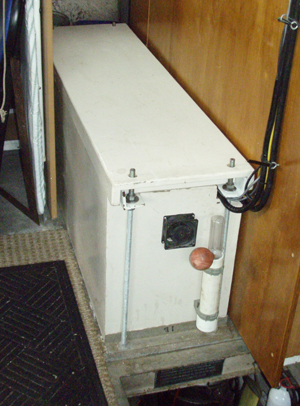To the editor: Recently I replaced the house batteries on my custom (I built it) 63-foot sailboat Bandersnatch (currently mastless). My four-year-old set of four Trojan L16HC 6V batteries developed a shorted cell. Virtually all of my battery replacements over the years were prompted by one or more bad cells so this time I decided to use six individual cells so I could replace a bad one if necessary.
 |
|
To make replacing failed cells easier, Norm Johnson installed six individual 2V cells in a custom-built battery box. |
My new house battery consists of six Trojan model L16RE 2V units. These are L16-size flooded lead-acid 2.2V cells of 1,110-Ah capacity (20-hour rating). The “RE” stands for “renewable energy” which means that these units have more substantial plate grids and 30 percent thicker insulating spacers to better withstand the rigors of frequent deep cycling. Both 6V and 2V types weigh about 120 pounds each.
L16RE 2V units are generally advertised on the Internet at around $330 each (plus $100 or more to ship), but I found them locally for $282 plus 7 percent sales tax and the old cores. Interestingly, the fellow who delivered the new units told us that they make more profit on recycling the cores than they do selling new units!
Aboard Bandersnatch we commonly discharge to about 200 to 250-Ah on a daily cycle. Conventional wisdom these days puts the discharge floor at 30 percent for the best balance between usefulness and longevity, but less the better. The old battery bank of four 6V L16 units was rated for 775-Ah (20-hour rate) yielding a 25 to 32 percent depth of discharge. The 1,100-Ah (20-hour rate) rating of the new house batteries will reduce the level of discharge to 18 to 22 percent so the batteries should last longer.
Some data from Trojan tech support: bulk charging voltage = 14.8V; float charging voltage = 13.2V; equalizing voltage: 15.5V and the factory-installed acid is at 1.277 specific gravity.
 |
|
Johnson’s battery box has a small fan and a screwed-down lid to contain the 2V cells. |
L16, like 8D (originally created as an eight-cylinder diesel engine starting battery), signifies the physical size of the case, not what is in it. My new 2V cells are built in the exact same cases as the old 6V units. The six new units fit perfectly into my battery box because I originally built it long enough to accommodate six L16 units since that dimension aligned nicely with the spacing of the deck beams to which the battery box is secured.
My battery box is constructed of 3/4-inch plywood with white Formica on the inside surfaces and fiberglass/epoxy sealing the bottom and up the sides about three inches. There are no feet or ribs on the bottom, so the batteries sit flat on the bottom of the box and the box sits flat on the saloon deck to support the weight evenly. The box and the batteries are held down using two steel angle irons a quarter-inch by two inches lengthwise across the tops of the units and four half-inch threaded rods tying the ends of the angle irons to the deck beams holding up the saloon deck. There are spacers (made from that plastic wood they sell for house backyard decks) between the steel angle and the battery tops to hold them down securely. I am confident that the boat could take a roll-over and the batteries will stay in place.
Various spacers keep the cells’ cases spaced 3/16-inch from each other and 3/8-inch from the box sides to allow air circulation for cooling. There is a three-inch muffin fan on one end of the box to move air through the box and out the other end when the battery is being charged.
A lid fits on the top of the box. I made the threaded rod to rise up through the lid and had nuts on the ends of the rod to secure the lid. But I thought that if there were a battery explosion, the fastened lid would cause the box to be blown apart adding to the mess. So I do not use the nuts so (hopefully) the lid will blow off and leave the box intact. That’s the theory anyway.
—Norm Johnson is a former USAF aircraft mechanic, and merchant marine radio officer. He built his boat Bandersnatch and currently cruises the East Coast of the U.S.

